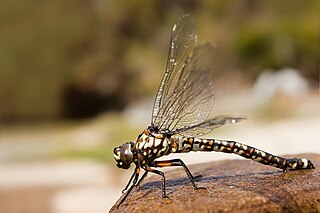
The Aeshnidae, also called aeshnids, hawkers, or darners, is a family of dragonflies, found nearly worldwide. The family includes some of the largest dragonflies.
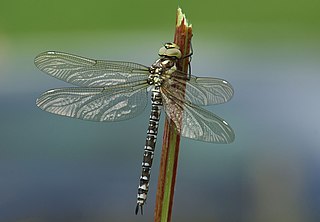
Aeshna, or the mosaic darners, is a genus of dragonflies from the family Aeshnidae. Species within this genus are generally known as "hawkers" or "darners".

Gynacantha is a genus of dragonflies in the family Aeshnidae. The females have two prominent spines under the last abdominal segment. This gives the genus name and the common name two-spined darners; they are also known as duskhawkers.
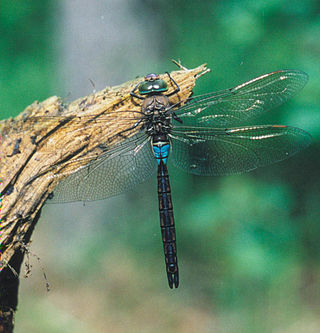
Anax is a genus of dragonflies in the family Aeshnidae. It includes species such as the emperor dragonfly, Anax imperator.

Austroaeschna is a genus of dragonflies in the diverse family Aeshnidae.

Nannophlebia is a genus of dragonfly in the family Libellulidae. They are commonly known as Archtails. The species are very small with black and yellow striped abdomens.

Austroaeschna anacantha is a species of dragonfly in the family Telephlebiidae, known as the western darner. It is found in south-western Australia, where it inhabits rivers and streams.
Telephlebiidae was formerly considered a distinct family of dragonflies endemic to eastern and south-western Australia. Recent taxonomic revisions have classified the species previously placed in Telephlebiidae within the family Aeshnidae.
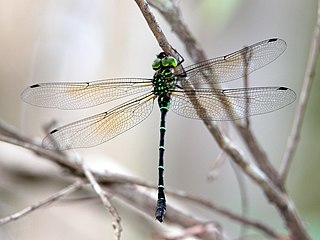
Dromaeschna forcipata is a species of dragonfly in the family Telephlebiidae, known commonly as the green-striped darner. It generally inhabits streams in coastal rainforests of north-eastern Queensland, Australia.
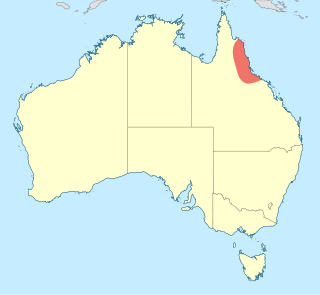
Dromaeschna weiskei is a species of dragonfly in the family Telephlebiidae, known as an ochre-tipped darner. It inhabits streams in coastal rainforests of north-eastern Queensland, Australia.
Antipodophlebia is a genus of dragonflies in the family Aeshnidae, There is only one species of this genus which is endemic to south-eastern Australia.

Notoaeschna is a genus of dragonflies in the family Aeshnidae, endemic to south-eastern Australia.

Spinaeschna is a genus of dragonflies in the family Aeshnidae. These dragonflies are endemic to eastern Australia, where they inhabit streams and rivers.

Telephlebia is a genus of dragonflies in the family Aeshnidae, endemic to eastern Australia. Species of Telephlebia are medium to large, dark chestnut brown dragonflies with dark markings on the leading edge of their wings. They are crepuscular and fly at dusk.

Notoaeschna sagittata is a species of Australian dragonfly of the family Telephlebiidae, known as the southern riffle darner. It is endemic to eastern Australia, occurring south of the Hunter River, New South Wales, where it inhabits rapid streams.

Telephlebia undia is a species of dragonfly in the family Telephlebiidae, known as the Carnarvon evening darner. It is a medium to large, dark chestnut brown dragonfly with dark markings on the leading edge and base of its wings. It is endemic to the vicinity of Carnarvon National Park in Central Queensland, Australia, where it inhabits streams near waterfalls, and flies at dusk.

Dendroaeschna is a monotypic genus of Australian dragonflies in the family Brachytronidae. The only known species of this genus is Dendroaeschna conspersa, commonly known as a wide-faced darner.
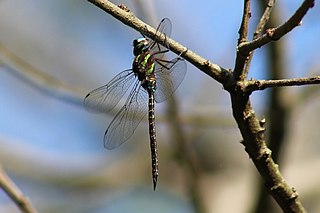
Rhionaeschna psilus, the turquoise-tipped darner, is a species of darner in the family Aeshnidae. It is found in the Caribbean, Central America, North America, and South America.
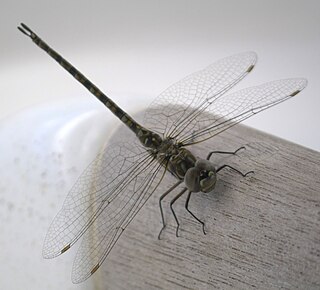
Gomphaeschna is a genus of pygmy darners in the dragonfly family Aeshnidae. There are about nine described species in Gomphaeschna.

Rhionaeschna californica, the California darner, is a species of darner in the dragonfly family Aeshnidae. It is found in Central America and North America. And prefers habitats like lakes, ponds, marshes and stream pools with edge vegetation including many with alkaline water conditions Larvae sustain themselves on a diet of aquatic insects,very small fish and tadpoles. The adult-stage will eat almost any soft-bodied flying insect.

















